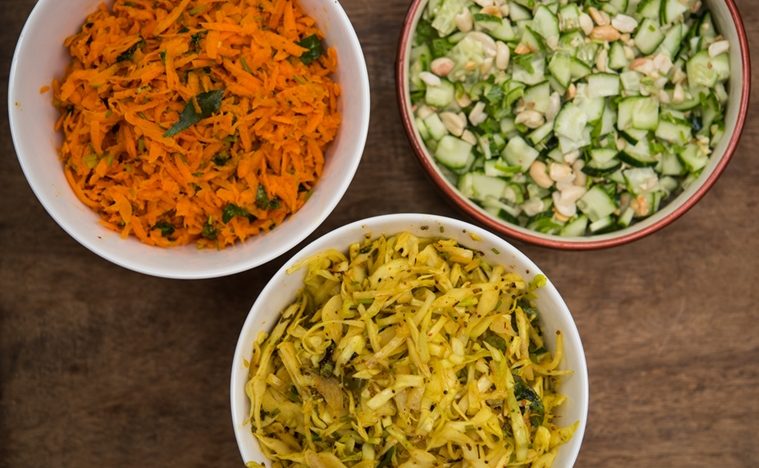I don’t like stating the obvious, but, thanks to growing awareness about eating healthy, salads have turned into rockstars. Our restaurants have a variety of salads from across the world, and more interestingly, we have also started making couscous and tabbouleh with native millets. The infusion of native flavours is encouraging. I have a small but significant concern, though. While most of these salads are healthy in their original form, the problem is when people consider raw vegetables loaded with dubious mayonnaise to be good for the body as well. A few leaves of lettuce don’t make a difference, and the usage of lettuce all round the year means we as consumers are forcing farming of leafy greens that actually use more natural resources than other seasonal vegetables.
Which brings me to our backyard and Indian salads. There is this misconception that Indian food is greasy — no, home-cooked Indian food is not — and that it lacks salads. The latter is not true either. We have a great variety of salads, though the appearance of the dishes may not always conform to the idea of a salad.
Technically all raw, steamed, boiled or even lightly stir-fried vegetables (and even some fruits) mixed with some sort of dressing or seasoning is a salad. No prizes for guessing that the dressing may convert into a tadka in an Indian context. After all, some fats mixed with the vegetables ensure the availability of fat soluble vitamins from the salad, and our tadka is a great infusion of spices that fits the bill beautifully.
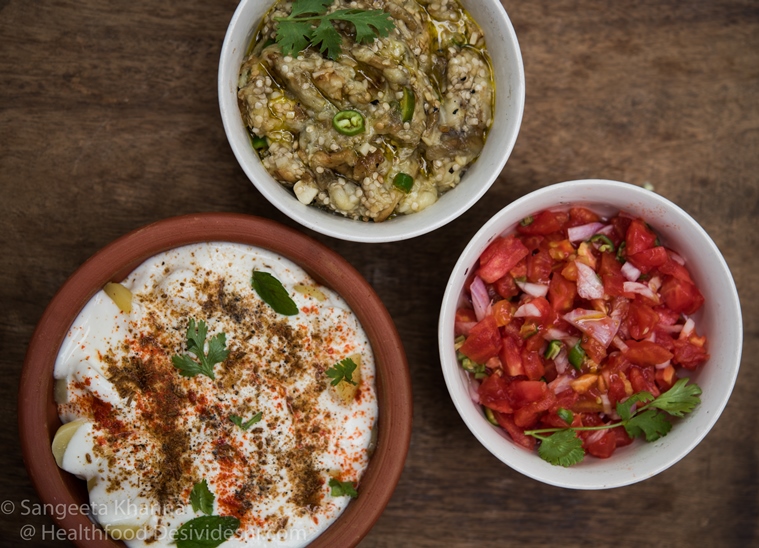
Khamang kakdi and the various cucumber salads of India
Each Indian state has its own variety of cucumber. Some are crunchy, some soft and some taste a lot like melons, with sizes varying from a few centimetres to a couple of feet. Uttarakhand’s large cucumbers are great for a chaat-like salad, with local herbed salt, local chillies, lemon rind and garlic chives or mint. Rajasthan’s Kaachri is used for a wonderful pickled salad and coarse chutneys (the same cucumber is known as Chibad in Punjab). Andhra’s Dosakayi is used in pachadis along with cumin, chillies and coriander leaves.
Cucumber Thayir pachadi from Tamil Nadu, Kheere ka raita from central and north India and Vellerika pachadi from Kerala are all great ways to celebrate cucumbers in the season. All these yogurt-cucumber combinations are, technically speaking, salads. The Maharashtrian/Gujarati Khamang kakdi is a versatile relish/salad that also serves as a snack/side-dish. Mixed with crushed roasted peanuts, some salt, sugar and chillies, this is a sassy way to enjoy crunchy cucumbers.
Carrot and cabbage sambharo
This semi-cooked salad benefits from a generous tadka and some turmeric (hing and turmeric provide both flavour and medicinal benefits). The sambharo, a well-balanced combination of tart, hot and sweet flavours, is generally served as a side dish. It is a permanent fixture on Gujarati thalis and is usually made using carrots or cabbage, or a mix of both.
Mung dal kosambari
This interesting lentil salad from Karnataka is made with raw split mung or split chickpeas. A generous lashing of freshly scraped tender coconut and a tadka of hing, mustard seeds and curry leaves makes it a delightful medley of textures and flavours. The kosambari is usually made for Navratri Prasad, but finds its way into everyday menus as well.
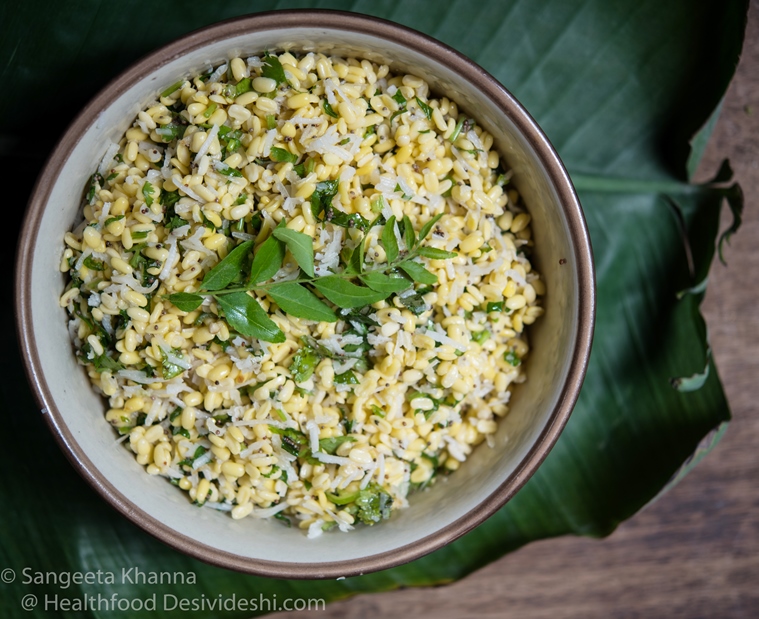 Mung Dal Kosambari from Karnataka is made with raw split mung or split chickpeas
Mung Dal Kosambari from Karnataka is made with raw split mung or split chickpeas
Ambe daal
Maharashtra’s Ambe dal is served as a side dish. Chana dal is soaked and crushed in a mortar and pestle to macerate it lightly. It is then mixed with grated raw mangoes, freshly scraped coconut and a flavourful tadka that gets infused beautifully into the crushed dal.
Hyderabadi chane ki daal
This preparation is served as a snack, or for breaking the fast during Ramzan. The cooked dal is rinsed and drained to remove starch. It is then mixed with lemon juice, salt and pepper, chopped green chillies and mint coriander greens.
Sprouts chaat
Sprouts made with assorted lentils and even soaked or boiled black chickpeas are sold by khomchawalas as street snacks. You can, of course, make these at home, and people across the country have their own variations. The chokha, bharta, pitika, sheddo and pora from different states make for an excellent mushy relish that serves as a salad with meals.
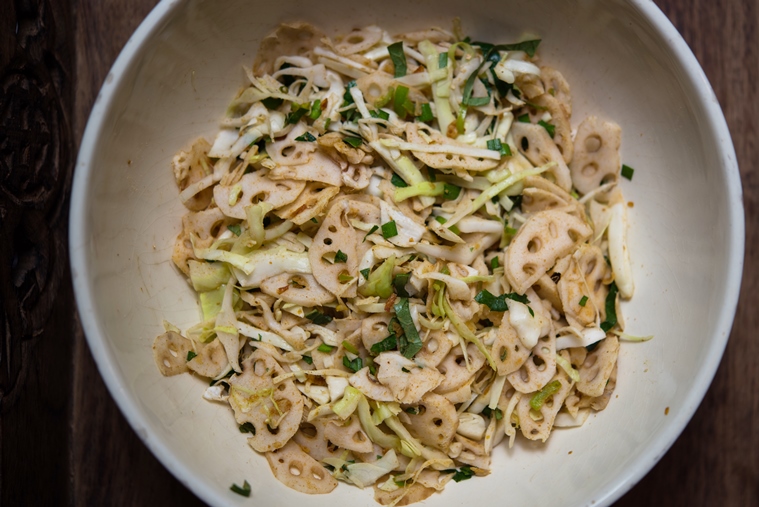 Lotus stem shingju is popular in and around Manipur both as a salad and snack. Photograph by Sangeeta Khanna
Lotus stem shingju is popular in and around Manipur both as a salad and snack. Photograph by Sangeeta Khanna
Smoked tomato onion relish (Tamatar ka chokha)
Fire-grilled vegetables are common in Indian cuisine, probably because food was always cooked on wood fires in olden days, and the smoky flavour was much valued. A piece of burning charcoal in now kept in the pot to impart a similar smoky effect to dal, or chokha, or even some curries. The Sikkimese Bilahi ko asar, or Assamese Bilahi pitika come to mind.
Smoked baingan chokha
Baingan or aubergine is one of the few native vegetables popular across India. UP’s fire-grilled smoked chokha, Assam’s Pitika and Bengal’s Begun pora make a perfect mash that classifies as a salad. The raw mustard oil along with green chilli-garlic and raw onion in this mash is an apt dressing. The Punjabi baingan ka bharta becomes a subzi with the addition of bhuna masala etc, but the chokha remains a salad.
Aam ka kuchla
Raw mangoes are an essential summer food. They prevent dehydration, alkalise the body and provide essential minerals. The aam ka kuchla is a quick pickled salad that fortifies summer meals with taste and nutrition.
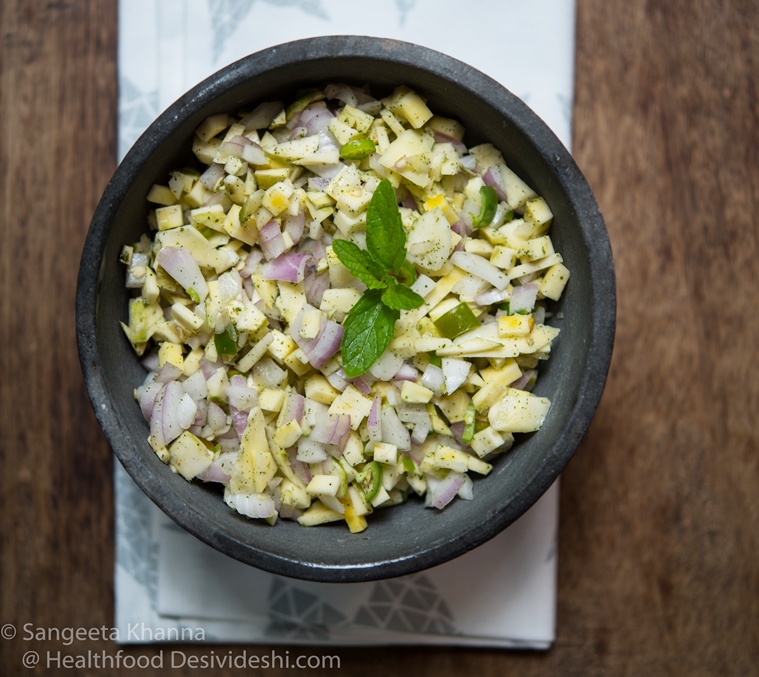 Aam ka Kuchla is a summer favourite.
Aam ka Kuchla is a summer favourite.
Pyaz ke lachhe
In the olden days, people were advised to keep a raw onion in their pocket whenever they ventured out in summer. The onion was supposed to help prevent heatstroke. Even farmers would begin their frugal meal by cracking a whole onion with their fist — this was a practical salad for the sons of the soil. Other salads featuring onions included vinegar-pickled baby onions and pyaz ka lachha, marinated with red chilli, salt and vinegar.
Kachalu
Kachalu is actually made with any boiled tuber, but the ubiquity of potatoes means we mostly enjoy it with sliced, boiled potatoes that are mixed with spiced thick yogurt.
Pahadi mooli ka raita
In Uttarakhand they add some yogurt and mustard powder to grated or crushed radish and make a wonderful raita. It is served along with alu ka gutka as a snack, or a small meal. This salad is often served at tea shops along with chai.
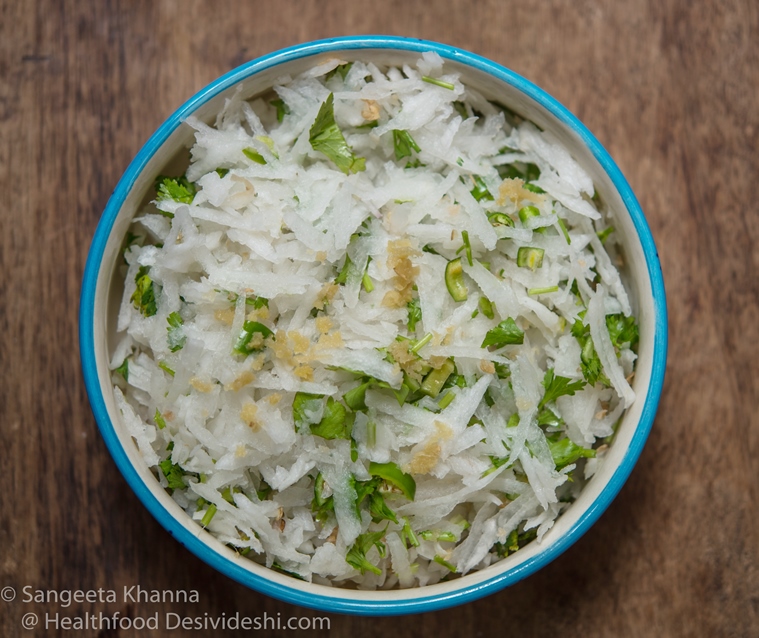 Mooli ka kas is very popular in northern India.
Mooli ka kas is very popular in northern India.
Mujj chetin
This, sort of, Kashmiri crushed radish chutney is served with meals, but is an integral part of the predominantly meat-based Kashmiri diet. Laced with caraway seeds, it helps digest meat-heavy meals.
Shingju
Shingju, popular in and around Manipur, is both as a salad and snack. Made with seasonal veggies, it is seasoned generously with charred ngari (fermented fish), cilantro, garlic chives and bhut jolokia. Lotus stem shingju is the most interesting, because of the unique use of thinly sliced fresh, crunchy lotus stems that is mixed with other ingredients.
Eromba
Eromba, also from Manipur, is made with starchy vegetables from the yam and taro family, local fox nuts, fleshy beans, or even okra. Paan Eromba is boiled and mashed colocasia with mint and ngari, or fermented bamboo shoot.
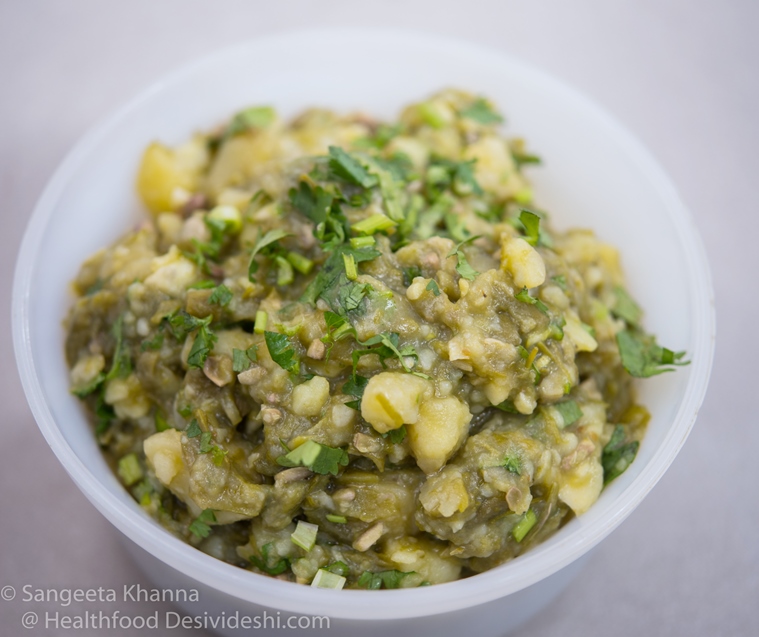 Gudok, from Tripura, is made with boiled seasonal vegetables and fermented fish.
Gudok, from Tripura, is made with boiled seasonal vegetables and fermented fish.
Gudok
Gudok, from Tripura, is a mushy preparation made with boiled seasonal vegetables and fermented fish. Local garlic chives are used for flavouring. The mashed Gudok looks unimpressive but tastes great and is highly nutritious.
Fruit chaats
You’d be familiar with the ubiquitous fruit chaats that use star fruit, pineapples and raw mangoes. These fruits, which grow in abundance, are also used in salads at home. But, then, there is also stuff like this: Makha batabi lebu (pomelo segments mixed with chilli, salt and mustard oil from Bengal and Assam), Amrood ki chaat from the plains, Pineapple wedges sprinkled with chilli and salt from the coastal states… Our penchant for using chillies, herbed salts and black rock salt also comes into play in these fruit salads.

